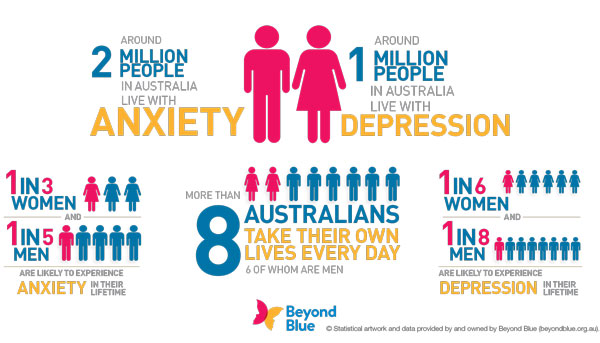How do you create a “Mentally Healthy Workplace?”
GAVIN MOREIRA, CMPA Member Services Manager provides information on understanding mental health and wellbeing.
In order to work at their best and contribute to the success of their organisation the health and wellbeing of staff is crucial. When staff aren’t feeling their best, they can’t work at their best.
Under Victorian OHS legislation employers must take steps to protect workers against risks to their physical and mental health.
Creating a mentally healthy workplace is a shared responsibility. All staff – from managers to employees – have a role to play.
On Tuesday 27th November 2018 I attended a WorkSafe workshop in Bendigo on Mental Health. A very informative workshop with about 40 attendees from various businesses in the area. There were three main presentations and a Q&A panel by all speakers to complete the workshop.
The first presentation was conducted by HALT (Hope Assistance Local Tradies) founder Jeremy Forbes.
HALT aims to remind tradies they are valued by their community, and direct them to support services, both local and national, should they need them. HALT (Hope Assistance Local Tradies) works in conjunction with communities to host ‘SAVE YOUR BACON’ brekkies.
Items raised from the presentation included a focus on early school leavers and apprentices who are potentially 16 to 18 years old. They go through three years of study and then go into the workforce.
They learn a trade but where is the education on – relationships, communication, finances, drugs and alcohol, domestic violence, bullying, suicide?
Workers, especially young workers need to be empowered to talk to people at the workplace.
Risk factors leading to being mentally unstable include:
- Unrealistic work deadlines, pressures to get jobs done
- Work / Life (family) is not balanced
- Lack of recognition at work
- Family / Personal issues
- Loss of employment
As a Manager are you a good listener or have empathy for your fellow colleagues or employees?
The second presentation was conducted by Terry Davies from Worksafe (Psychosocial Team) based in Geelong. He discussed issues relating to stress factors on the job which could be physical, mental, emotional or behavioural in nature.
What is Bullying? – Negative behaviour that becomes a risk to the health and safety of all on the work site.
Tasks that are not considered bullying which are of a reasonable nature include – performance management, rostering, constructive feedback.
Risks contributing to Workplace Bullying could include:
- Job design / description
- Does a new staff member understand their role? If not look at the induction process and your systems of work.
- Do you have an employee Code of Conduct?
- How strict are the use of Manners in the workplace? – Common sense for some!!
Different Workplace Strategies were looked at, under the headings of Job Design – flexible work hours, Team Factors and Organisational Factors – Do you have an Anti-bullying policy or a Social Media policy? How do you manage changes in the business or workplace?
Outcomes of Workplace Bullying include – high staff turnover, increased absenteeism, lost productivity, poor public image. Cyber Bullying – develop a Social Media Policy (internet and emails).
Train staff on what is acceptable or not acceptable behaviour in the workplace.
Worksafe Psychosocial Inspectors – If a claim for bullying has been raised?
Employers must document all communications with staff.
Evidence must be provided to show that reasonable actions have been taken to make changes in the workplace. Be transparent with staff. You must have policies and procedures in place. Training and refresher training to be provided or be made available to staff. This could include being added on to a Toolbox meeting.
The third presentation was conducted by Catherine Doherty from Beyond Blue.
How do you create a “Mentally Healthy Workplace?” was the question for the group and the basis of the presentation.
Items raised included understanding mental health and wellbeing.
Mental health is a positive concept related to the social and emotional wellbeing of people and communities. The concept relates to the enjoyment of life, ability to cope with stress and sadness, the fulfillment of goals and potential, and a sense of connection to others.
With much of people’s time each day spent at work, the workplace is a very influential environment when it comes to mental health and wellbeing. A positive and supportive workplace can mean the difference between functioning positively or negatively.
Statistics on Mental Health Conditions
Anxiety – effects around 2 million people in Australia (1 in 3 Women and 1 in 5 Men)
Depression – effects around 1 million people in Australia (1 in 6 Women and 1 in 8 Men)
Suicide – around 8 Australians take their own lives each day (2 Women and 6 Men
Poor Mental Health costs around $10.9 Billion a year and affects 1 in 5 employees.
Every $1 spent on effective mental health initiatives will on average have a positive return on investment of $2.30 to your business.

A Mentally Healthy Workplace sees employees working smarter, giving their best efforts, are recognised for their efforts and go home with energy at the end of each day.
To obtain a positive workplace culture a strategic approach is required:

PROTECTION – mental health of staff
PROMOTION – wellbeing in the workplace
SUPPORT – addressing mental health conditions, regardless of cause
In addition to applying the integrated approach model (above), there are three key principles that will help to successfully implement a mental health and wellbeing strategy – commitment of senior leaders and business owners, ongoing meaningful participation by employees and ongoing communication.
Employers need to develop a workplace mental health and wellbeing strategy to help promote positivity in the workplace. A safe workplace is a positive workplace.
For further information refer to:
www.headsup.org.au, www.beyondblue.org.au and or www.workwell.vic.gov.au
CMPA will look to co-ordinate workshops in the new year.









You must be logged in to post a comment Login